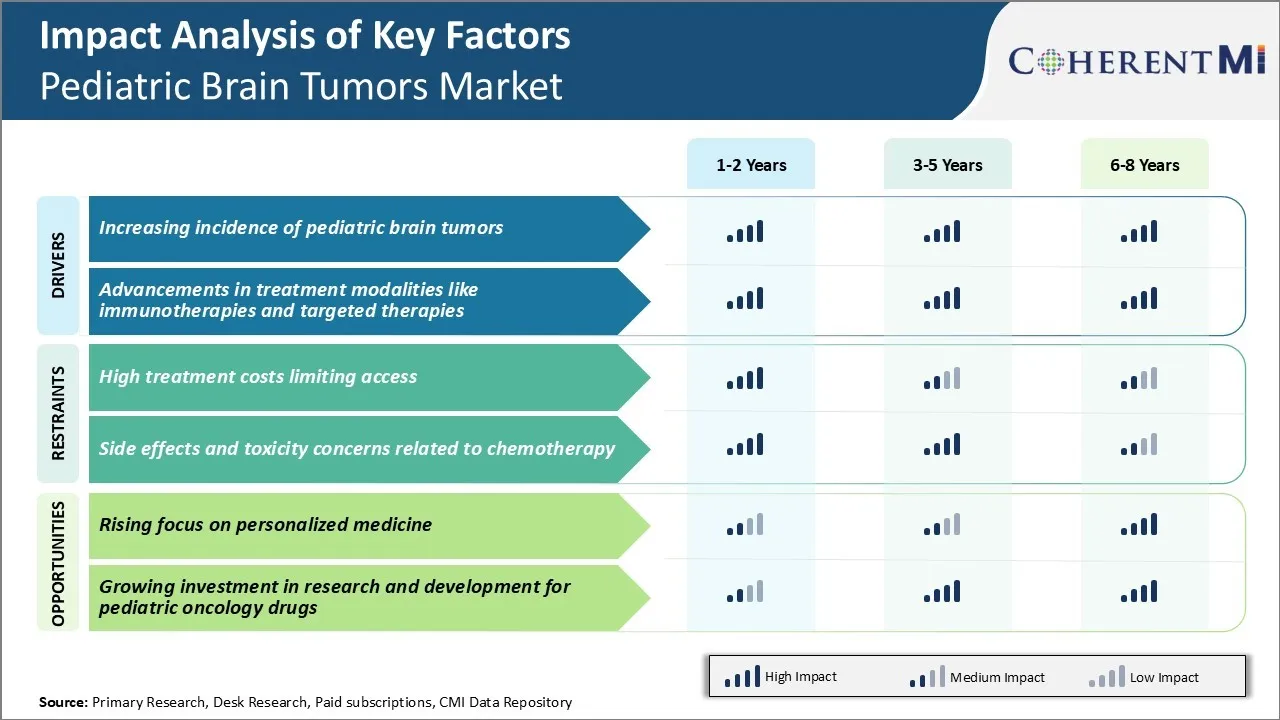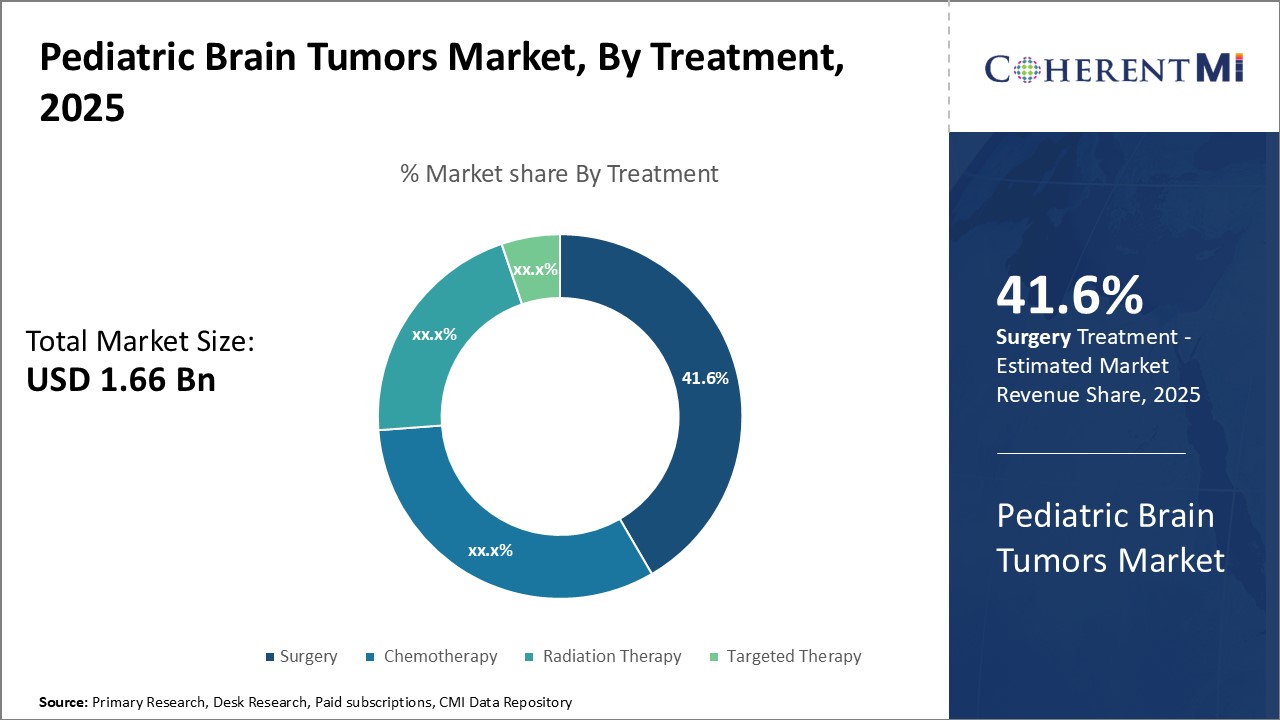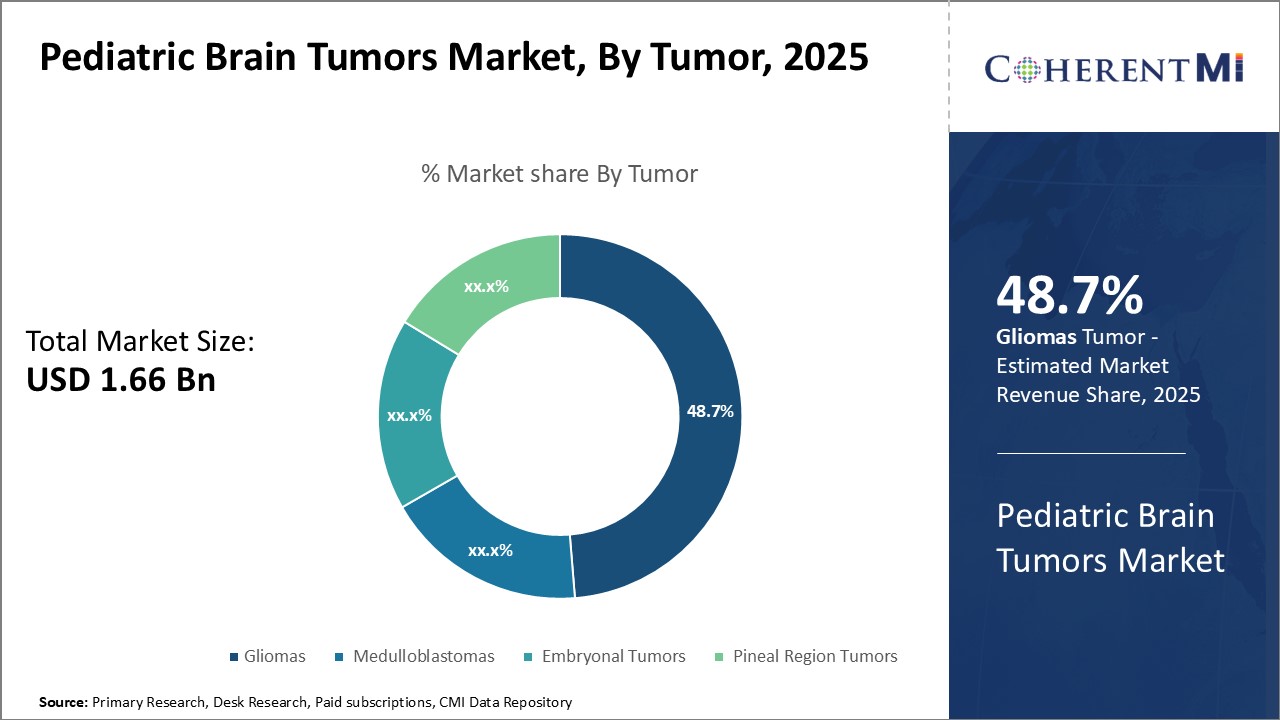Pediatric Brain Tumors Market Size - Analysis
Market Size in USD Bn
CAGR7.1%
| Study Period | 2025-2032 |
| Base Year of Estimation | 2024 |
| CAGR | 7.1% |
| Market Concentration | High |
| Major Players | Novartis, Pfizer, Bayer, Bristol-Myers Squibb, Eli Lilly and Company and Among Others |
please let us know !
Pediatric Brain Tumors Market Trends
One of the key drivers for the pediatric brain tumors market has been the rising incidence of various forms of pediatric brain and central nervous system (CNS) tumors. While CNS tumors are relatively rare in children, accounting for less than 20% of childhood cancers, recent studies indicate their incidence rates have been increasing gradually. In the United States alone, over 4,500 new cases of pediatric brain and CNS tumors are diagnosed each year according to estimates.
Even after successful treatment such as surgery and chemotherapy, long term survivors are often afflicted with debilitating side effects and functional disabilities. This puts immense strain on the children, their families as well as healthcare systems and drives the need for newer and more effective therapies.
Continuous progress is being made in the management of pediatric brain cancers owing to ongoing research efforts. One of the key drivers augmenting the market potential is the advancements occurring in treatment modalities such as immunotherapy and targeted therapies.
Several targeted therapies targeting tumor-specific gene mutations and growth factor receptors are in the pipeline. Some have already been approved or received breakthrough designation for pediatric use from the FDA. Their relative precision in attacking vulnerable molecular pathways holds out hope for improved efficacy while also sparing healthy tissues from collateral damage. They can also be given orally instead of through infusions or injections as needed.

Market Challenge - High treatment costs limiting access
According to various studies, the average cost of treatment for pediatric brain tumors in the US ranges from $100,000 to $500,000 depending on the type and stage of tumor. This disproportionately high financial burden means that many families, especially those who are uninsured or underinsured, find it extremely difficult to pay for the entire course of treatment and care of their child.
One of the key opportunities available in the pediatric brain tumors market is the rising focus on personalized medicine. With advancements in fields like cancer genetics and molecular biology, medical researchers now have a better understanding of the various genetic, molecular and biological factors underlying different types of pediatric brain tumors. This growing knowledge is enabling the development of personalized treatment approaches tailored to the unique profile and needs of each individual young patient.
It also helps healthcare providers make more informed decisions by predicting risks, tailoring screening methods as well as choosing the most optimal treatment pathway for each pediatric brain tumor case. The rising focus on personalized treatments holds immense potential to improve health outcomes, minimize side effects and enhance quality of life for pediatric brain tumor patients in the future.
Prescribers preferences of Pediatric Brain Tumors Market
The standard first-line treatment for most pediatric brain tumors is surgery followed by radiation therapy. Chemotherapy may also be used depending on the tumor type, location, and stage. For low-grade astrocytomas, which are the most common type, close observation with serial MRI monitoring is preferred over immediate treatment in early stages. Chemotherapy alone using oral medications such as carbamazepine (Tegretol) may be sufficient.
Other factors like the child's age, size and location of the tumor, and surgical risks also influence decisions. Prescribers strive to balance maximizing survival benefits with minimizing long-term side effects like neurocognitive deficits, which are critical considerations for pediatric patients. Overall treatment goals include long-term disease control with preservation of quality of life.
Treatment Option Analysis of Pediatric Brain Tumors Market
Pediatric brain tumors can be categorized into different stages based on factors like tumor size, location and whether it has spread. The initial stages involve localized tumors that have not spread. The most common treatments here are surgery, radiation therapy and chemotherapy.
Chemotherapy uses drugs to reach cancer cells throughout the body. Drugs like carboplatin and vincristine are commonly used either alone or in combinations for low-grade tumors. For more aggressive cancers, combinations of carboplatin, vincristine and lomustine are preferred. These multi-drug regimens have shown higher tumor response rates while preserving organ function in pediatric patients.
Key winning strategies adopted by key players of Pediatric Brain Tumors Market
Focus on developing targeted therapies: One of the major strategies adopted by companies like Amgen, Novocure, Bristol-Myers Squibb, etc. is focusing on developing targeted therapies that can improve treatment outcomes for pediatric brain tumors. For example, Amgen developed Bevacizumab (Avastin), a VEGF-targeted therapy, for recurrent pediatric gliomas in 2012.
Invest in immunotherapy research: Given promising results in adult brain tumors, players are increasingly investigating immunotherapy approaches for pediatrics. Bristol-Myers Squibb is conducting several Phase 1/2 clinical trials evaluating immune checkpoint inhibitors like nivolumab alone or in combination for recurrent pediatric high-grade gliomas since 2017.
Segmental Analysis of Pediatric Brain Tumors Market
 Insights, By Treatment: Surgical Advancements Drive Higher Adoption
Insights, By Treatment: Surgical Advancements Drive Higher AdoptionIn terms of treatment, surgery is estimated to account for 41.6% share of the pediatric brain tumors market in 2025, owning to continual improvements in surgical techniques and technologies. For many pediatric brain tumors, surgical resection remains the foundation of treatment. Advances such as intraoperative MRI, advanced neuro-navigation systems, ultrasonic aspiration devices, and laser interstitial thermal therapy have enabled surgeons to remove more of the tumor mass while better preserving critical brain functions. This has translated to improved clinical outcomes for conditions like low-grade gliomas and certain midline tumors.
As surgical skill and supporting technologies progress further, the acceptable extent of resection is being redefined. Certain extremely invasive tumor types that were previously deemed inoperable, such as diffuse intrinsic pontine glioma, are now targets of aggressive surgical trials. Institutional expertise has proliferated through fellowships and specialized training programs focused on pediatric neuro-oncology. Widespread adoption of minimally invasive endoscopic techniques is enhancing recovery. All of these factors consolidate surgery's role at the forefront of initial management.

In terms of tumor, gliomas are projected to hold 48.7% share of the market in 2025, given their infiltrative growth pattern. They account for approximately 25-30% of all pediatric brain tumors. Low-grade gliomas are particularly common in the pons and thalamus regions, while high-grade forms have poor survival outcomes. Unlike surgically accessible localized masses, gliomas extend multi-focal fingerlings throughout the brain parenchyma. Even with maximal safe resection, residual microscopic disease is nearly impossible to fully remove.
Experimental targeted drugs like carmustine wafers, bevacizumab, and selumetinib show promise against specific molecular tumor subclasses. Ongoing research aims to translate adult findings on anti-angiogenic and immune checkpoint inhibitors to Pediatric applications. Additionally, comprehensive genome analysis is elucidating new genomic alterations that may serve as future drug targets. Overall, aggressive utilization of systemic modalities remains necessary due to gliomas' infiltrative growth pattern.
Insights, By Patient Age: Adolescent Care Emphasizes Transition to Adult Providers
Successful models emphasize self-management skills, psycho-oncology support, sexuality counseling and coordinated care between pediatric and adult providers. Transition programs aim to transfer clinical information, coordinate sub-specialty follow-up and foster self-advocacy skills. They address challenges in navigating adult facilities that lack dedicated Child Life specialists and teen-friendly spaces.
Additional Insights of Pediatric Brain Tumors Market
- Pediatric brain tumors account for nearly 20% of all childhood cancers, with the most common being gliomas. These cancers are more prevalent in developed countries due to higher detection rates but pose a challenge in low-income regions due to a lack of advanced medical infrastructure.
- Pediatric brain tumors represent approximately 20% of all childhood cancers.
- Survival rates vary, with a 5-year survival rate of about 75% for low-grade tumors and significantly lower rates for high-grade tumors.
Competitive overview of Pediatric Brain Tumors Market
The major players operating in the pediatric brain tumors market include Novartis, Pfizer, Bayer, Bristol-Myers Squibb, Eli Lilly and Company, Biodexa Pharmaceuticals, Cellectar Biosciences, and Midatech Pharma.
Pediatric Brain Tumors Market Leaders
- Novartis
- Pfizer
- Bayer
- Bristol-Myers Squibb
- Eli Lilly and Company
Pediatric Brain Tumors Market - Competitive Rivalry

Pediatric Brain Tumors Market
(Dominated by major players)
(Highly competitive with lots of players.)
Recent Developments in Pediatric Brain Tumors Market
- In June 2024, Pfizer introduced a new immunotherapy drug aimed at treating high-grade gliomas in pediatric patients, expected to enhance survival rates by targeting specific tumor proteins. Pfizer has been actively involved in oncology, including brain cancer research.
- In March 2023, Novartis announced promising results from their Phase II/III TADPOLE trial, which evaluated the efficacy of a targeted therapy using Tafinlar (dabrafenib) and Mekinist (trametinib) for pediatric patients with low-grade glioma (LGG) carrying the BRAF V600E mutation. This combination therapy significantly reduced tumor size, showing an overall response rate of 47%, compared to just 11% in patients treated with chemotherapy.
In July 2020, Bristol-Myers Squibb received FDA approval for an immunotherapy drug designed to treat recurrent medulloblastoma, offering a new line of treatment for patients unresponsive to conventional therapies. Bristol-Myers Squibb has received several FDA approvals for cancer therapies, including approvals for combination treatments involving nivolumab (Opdivo) and ipilimumab (Yervoy), but these were focused on other cancers such as non-small cell lung cancer and lymphoma, rather than medulloblastoma.
Pediatric Brain Tumors Market Segmentation
- By Treatment
- Surgery
- Chemotherapy
- Radiation Therapy
- Targeted Therapy
- By Tumor
- Gliomas
- Medulloblastomas
- Embryonal Tumors
- Pineal Region Tumors
- By Patient Time
- Pediatric
- Adolescent

Would you like to explore the option of buying individual sections of this report?
Vipul Patil is a dynamic management consultant with 6 years of dedicated experience in the pharmaceutical industry. Known for his analytical acumen and strategic insight, Vipul has successfully partnered with pharmaceutical companies to enhance operational efficiency, cross broader expansion, and navigate the complexities of distribution in markets with high revenue potential.
Frequently Asked Questions :
How big is the pediatric brain tumors market?
The pediatric brain tumors market is estimated to be valued at USD 1.66 Bn in 2025 and is expected to reach USD 2.68 Bn by 2032.
What are the key factors hampering the growth of the pediatric brain tumors market?
High treatment costs limiting access and side effects and toxicity concerns related to chemotherapy are the major factors hampering the growth of the pediatric brain tumors market.
What are the major factors driving the pediatric brain tumors market growth?
Increasing incidence of pediatric brain tumors and advancements in treatment modalities like immunotherapies and targeted therapies are the major factors driving the pediatric brain tumors market.
Which is the leading treatment in the pediatric brain tumors market?
The leading treatment segment is surgery.
Which are the major players operating in the pediatric brain tumors market?
Novartis, Pfizer, Bayer, Bristol-Myers Squibb, Eli Lilly and Company, Biodexa Pharmaceuticals, Cellectar Biosciences, and Midatech Pharma are the major players.
What will be the CAGR of the pediatric brain tumors market?
The CAGR of the pediatric brain tumors market is projected to be 7.1% from 2025-2032.